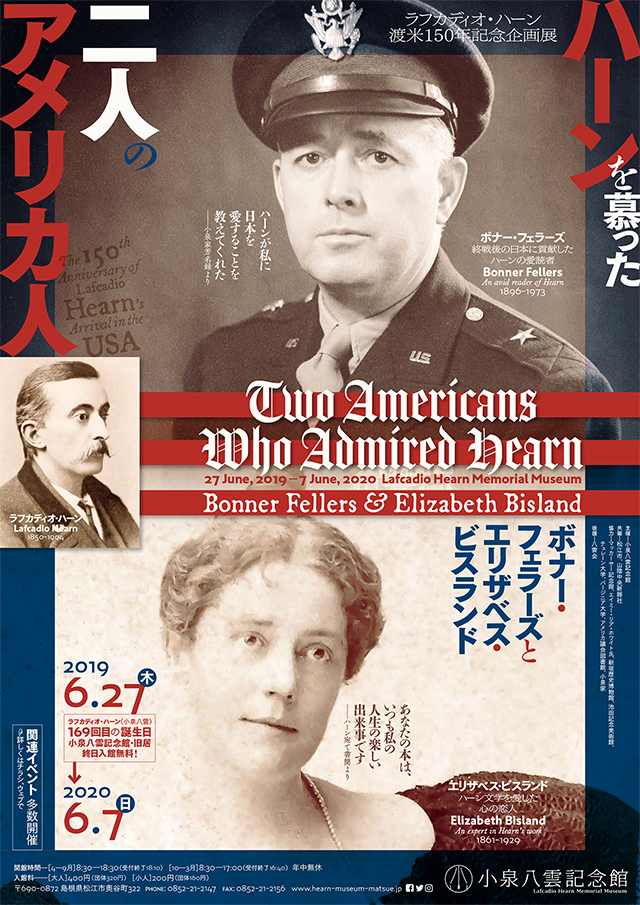企画展
ハーンを慕った二人のアメリカ人
ボナー・フェラーズとエリザベス・ビスランド
Exhibition
Two Americans Who Admired Hearn
Bonner Fellers & Elizabeth Bisland
ラフカディオ・ハーン渡米150年記念企画展
2019年6月27日(木)―2020年6月7日(日)
1階 展示室3
※新型コロナウイルス感染拡大防止のため臨時休館していましたが、6月1日(月)より再オープンいたします。開館予定の最新情報は「お知らせ」でご案内いたします。
2019年は、ラフカディオ・ハーン(小泉八雲 / 1850-1904)がアメリカにわたって150年。ハーンは、シンシナティとニューオーリンズで約20年間ジャーナリストとして文才を発揮し、その豊かな経験と確かな筆力は来日後の著作に多大な影響を与えました。この企画展では、生涯の友人でハーン文学の最大の理解者であるエリザベス・ビスランドと、ハーンの愛読者で彼の日本理解をもとに戦後日本の象徴天皇制の実現に力を尽くしたボナー・フェラーズを取り上げます。2人を通して、ハーンが日米相互理解に及ぼした「光」に迫ります。
主催:小泉八雲記念館
共催:松江市、山陰中央新報社
協力:マッカーサー記念館、エイミー・リア―・ホワイト氏、新宿歴史博物館、
池田記念美術館、テュレーン大学、バージニア大学、アメリカ議会図書館、小泉家
後援:八雲会
Exhibition: The 150th Anniversary of Lafcadio Hearn’s Arrival in the USA
Thursday June 27, 2019–Sunday June 7, 2020
Exhibition Room 3
Notice of Reopen from June 1st
The year 2019 marks 150 years since Lafcadio Hearn (Koizumi Yakumo, 1850-1904) arrived in the USA as an Irish immigrant. In the USA, he overcame much hardship and eventually worked as a writer, and as a journalist at four newspapers, in Cincinnati and New Orleans. This was work at which he excelled. In this exhibition, we aim to shine a light on Hearn’s influence on the later mutual understanding between Japan and the USA. We will do this by focussing on two Americans who had an understanding of Japan and were admirers of Hearn — Elizabeth Bisland, an expert in Hearn’s work, and Bonner Fellers, an avid reader of Hearn.
organizer: Lafcadio Hearn Memorial Museum
co-organizers: Matsue City / The San-in Chuo Shimpo Newspaper Co., Ltd.
cooperation: The MacArthur Memorial / Amy Lear White (Granddaughter of Bonner Fellers) / Shinjuku Historical Museum / Ikeda Art Museum /
Tulane University / Virginia University / Library of Congress / Koizumi Family
sponsor: The Hearn Society



The Exhibition Catalog
本体1,500円+税
¥1,500 (excluding tax)
1階ミュージアムショップおよび郵送販売にて取り扱います。
詳しくは会期中のイベントをご覧ください。

(1861-1929)
エリザベス・ビスランドとの永遠の友情
ハーンの才能を早くから見出していた一人に、エリザベス・ビスランド(1861-1929)がいる。
ルイジアナのプランテーションに生まれたエリザベス・ビスランドは、1882年の冬、ハーンの記事「死んだ花嫁」を読んでジャーナリストを志し、ハーンが文芸部長を務めるタイムズ=デモクラット社に入社した。その後ニューヨークに移り「ザ・サン」や「コスモポリタン・マガジン」などで編集者や花形記者として活躍する。1889年には、同じ女性記者のネリー・ブライと世界一周を競ってハーンより一足先に日本の土を踏んだ。1891年に法律家のチャールズ・W. ウェットモアと結婚。ハーンの没後、日本に3回来日し、親日家としても知られていた。
ハーンとの生涯にわたる深い交友は、おびただしい往復書簡が物語っている。八雲の長男一雄は著書『父小泉八雲』(1954年 / 小山書店)で、「エリザベス・ビスランド女史との親交は、あるいは一種の恋愛ともいえるかもしれぬ。しかし、それは白熱の恋ではない。沢辺の蛍のごとき清冽な恋である」と書いている通り、二人は才知を見せ合い、尊敬し合い、共感し合いながら理想的な友情を保った。ハーンは、来日後9作目の『日本雑記』(1901年 / Little Brown & Co.)をビスランドに捧げている。
ビスランドは、ハーンの没後2年目に、生前ハーンと交友のあった友人知人にあてた多くの手紙を集めて編集した『ラフカディオ・ハーンの人生と書簡』(1906年 / Houghton Mifflin & Co.)二巻と『ラフカディオ・ハーンの日本時代の書簡』(1910年 / Houghton Mifflin & Co.)を出版し、さらに残された遺族への支援も惜しまなかった。
1922年、ビスランドは4度目の来日の際、松江の小泉八雲旧居を訪れている。そして1929年、67歳でその生涯を閉じた。
Lifelong friendship with Elizabeth Bisland
Elizabeth Bisland (1861-1929) was one of the first people to recognise Hearn’s talent.
Bisland was born on a plantation in Louisiana. In the winter of 1882, she read Hearn’s article called The Dead Wife, and decided to become a journalist. She joined the Times-Democrat, where Hearn was literary editor. Later, she moved to New York, where she worked as an editor and became a prominent reporter for publications including The Sun and Cosmopolitan magazine. In 1889, she raced around the world against a fellow female journalist, Nellie Bly, and actually arrived in Japan before Hearn. In 1891, she married a lawyer named Charles W. Wetmore. After Hearn’s death, she visited Japan three times, and was known as a Japanophile.
Her deep, lifelong friendship with Hearn is shown in their prolific correspondence. Hearn’s eldest son, Kazuo, wrote in Father Koizumi Yakumo (Koyama Shoten, 1954) “The friendship with Elizabeth Bisland could be said to be a kind of love. Not a blinding passionate kind of love, but a clear form of love, like the light of a firefly.” They maintained an ideal friendship, based on mutual intelligence, respect and empathy. Hearn dedicated his eighth work written in Japan, A Japanese Miscellany (Little Brown & Co., 1901), to Bisland.
Two years after Hearn’s death, Bisland collected the many letters Hearn had sent to his friends and acquaintances and published the two volumes of The Life and Letters of Lafcadio Hearn (Houghton Mifflin & Co., 1906), and The Japanese Letters of Lafcadio Hearn (Houghton Mifflin & Co., 1910). She also supported his family.
In 1922, on her fourth trip to Japan, Bisland visited the former residence of Hearn in Matsue. She died in 1929, at the age of 67.

(1896-1973)
ハーンの愛読者ボナー・フェラーズ
ボナー・フェラーズ(1896-1973)は、アメリカ陸軍将校でマッカーサーの腹心として日本の戦後処理にあたり、今日の象徴天皇制の端緒を切り拓いたとされる人物である。
米国イリノイ州リッジファームで生まれたフェラーズは、インディアナ州にあるクエーカー派のアーラム大学に進み、そこで日本人の留学生の渡辺ゆりと出会った。彼女から紹介されたラフカディオ・ハーンに傾倒し、すべての著作を集め読破した。ハーンの「日本人の祖先崇拝と天皇崇拝は不可分の関係にある」とする日本文化理解に深く共感し、天皇の力を民主的に生かす新しい日本の戦後を提案したと言われている。2012年には、フェラーズを主人公とするハリウッド映画「終戦のエンペラー」(ピーター・ウェーバー監督)も制作、公開された。
フェラーズは、戦前より小泉家とも親交が深く、「ハーンが私に日本を愛することを教えてくれた」と妻のセツに語った。フェラーズは長男一雄と親友になり、戦後の混乱の中でハーンの遺族を探し出し、一雄と涙の再会を果たした。フェラーズの人間性に心を打たれた一雄は、『父小泉八雲』の中で、「日本はアメリカに戦争で負けた。科学で負けた。が今、人情でも氏に負けた」と述懐している。
フェラーズは帰国後もハーンの遺族への物心両面での支援と交流を続け、手紙のやり取りは1965年に一雄が亡くなったあとも続いた。また、一雄とフェラーズの娘ナンシーとの共著『リ・エコー』(1957年 / The Caxton Printing)出版のために奔走し、ハーンを通して日米友好に生涯をささげた。曾孫の小泉凡の名も「Bonner(ボナー)」に由来する。1973年、自宅のあるワシントンンDCで生涯を閉じ、アーリントン墓地に眠る。
Bonner Fellers, an avid reader of Hearn’s works
Bonner Fellers (1896-1973) was a US army officer, and served as MacArthur’s confidant in Japan at the end of the war. He paved the way for the creation of the modern symbolic role of the Emperor.
Fellers was born in Ridge Farm, Illinois in the USA. He studied at the Quaker school, Earlham College, where he met a Japanese exchange student named Yuri Watanabe. She introduced him to the works of Hearn, and he read all of Hearn’s books devotedly. He shared Hearn’s understanding of Japanese culture, empathizing with the latter’s assertion that the ancestor worship of the Japanese was inseparable from Emperor worship. It is said that he proposed a new post-war system for Japan, which utilized the power of the Emperor within a democracy. In 2012, Fellers was a central character in the Hollywood film Emperor (directed by Peter Webber).
Fellers had been friends with the Koizumi family since before the war, and told Hearn’s wife, Setsu, that Hearn had taught him to love Japan. He became close friends with Hearn’s eldest son, Kazuo, and in the post-war turmoil, he searched for Hearn’s family, leading to a tearful reunion with Kazuo. Touched by the humanity of Fellers, Kazuo reminisced in Father Koizumi Yakumo. “Japan lost to America through war. It lost by science. Now, it has lost to Fellers’ humanity.”
After returning to the USA, Fellers continued to support Hearn’s family both spiritually and materially. He continued to correspond by letter even after the death of Kazuo in 1965. He worked to bring the book Re-echo (The Caxton Printers, 1957), written by Kazuo and Fellers’ daughter Nancy, to publication. He devoted his life to promoting Japanese-American friendship through his knowledge of Hearn. Bon Koizumi, the great-grandson of Lafcadio Hearn, is named after him. He was living in Washington DC when he died in 1973, and is buried in Arlington National Cemetery.

Lafcadio Hearn, Japan—An Attempt at Interpretation, 1904, Houghton, Mifflin & Co.
ビスランドは、ハーンによるアメリカのコーネル大学での講義が実現するよう最大限の支援をしたものの、結局実現しなかった。しかしこの日本文化に関する講義用の草稿は、一冊の書物として出版され、ハーンの遺作となる。祖先信仰を基軸とする日本の宗教の意味を、家庭・地域社会・国家という3つのレベルで論じた本書は、フェラーズの日本理解に大きな影響を与えた。
(小泉八雲記念館所蔵)

Lafcadio Hearn, Japanese Miscellany, 1901, Little Brown & Co.
ハーンは、「あなたが日本について書く本を読みたい」というビスランドの言葉を生涯心に持ち続けた。来日後9冊目の著作となる『日本雑記』を、ビスランドに捧げている。
(小泉八雲記念館所蔵)

Kazuo Hearn Koizumi, Re-Echo, 1975, Caxton Printers
フェラーズは、アメリカ帰国後も小泉家と親交を続け、中でも『リ・エコー』出版のために奔走した。この本は、一雄が父から施された家庭教育の内容と思い出を綴ったもので、フェラーズの長女ナンシーとの共著によって1,000部限定で出版された。最近になって、この時の夥しい手紙のやり取りが見つかり、両家の交流を知る貴重な資料となっている。
(小泉八雲記念館所蔵)

Letters form Hearn to Bisland
ハーンは生涯を通じて、ビスランドに夥しい数の書簡を書いている。中には、ラブレターといえるようなものもあるが、二人は互いに尊敬しあい、才知を見せ合った文学上のよき理解者で親友だったというのがふさわしい。ハーンの没後、ビスランドの編集によって、友人たちに宛てた書簡は2巻からなる『ラフカディオ・ハーンの生涯と書簡』として出版された。
(バージニア大学所蔵)

Letters from Bisland to Hearn
法律家のチャールズ・W.ウェットモアと結婚したビスランドは、1895年ごろから再び日本にいるハーンと文通をはじめ、アメリカで仕事がしたいという彼の願いを叶えようと奔走した。小泉家に残されたビスランドからハーン宛の書簡は、知られざるビスランドの実像に迫る貴重な資料として、今回初めて往復書簡の形式で展示される。
(池田記念美術館所蔵)

Visitors’ Book of Koizumi Family
1930年、妻ドロシーを伴って小泉家を訪問したボナー・フェラーズは、芳名録に「ハーンが私に日本を愛することを教えてくれた」(Hearn taught me to love Japan.)と記している。また、1945年11月の一雄の52回目の誕生日を寿ぐお祝いを寄せている。
(小泉家所蔵)

Visitors’ Book of Lafcadio Hearn’s Former Residence
1922年、4度目(最後)の来日を果たしたビスランドは、かつての親友が住んだ松江の旧居を訪れ、芳名録に美しいメッセージを残した。またニューオーリンズの友人に宛てて、「この家は、日本人によって聖地のように保存されていた」と知らせている。
(根岸家所蔵)
